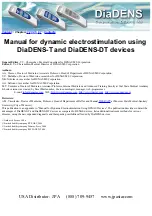
17
6 Cleaning, Care and Maintenance
6.1
General care
•
Avoid touching sharp and piercing objects with LiftSuit.
•
Ensure that the LiftSuit is stored in a dry and ventilated place without direct sunlight.
•
Keep your LiftSuit clean from oil and chemicals that could damage it.
6.2
Inspections
For the visual inspection, follow the checklist below:
Activation Mechanism:
Are there any signs of
wear and tear on the
activation buckle
(rounded spikes)?
Activation Mechanism:
Are there any signs of
wear and tear on the
activation straps
obviously created by
abrasion and interaction
with the buckle?
CONDUCT A VISUAL INSPECTION OF YOUR LIFTSUIT AT LEAST ONCE A MONTH
TO ENSURE THAT THERE ARE NO PROBLEMS CAUSED BY WEAR AND TEAR. IN
CASE YOU IDENTIFY A POSSIBLE PROBLEM, REMOVE THE LIFTSUIT FROM
OPERATION AND CONTACT THE MANUFACTURER.
Summary of Contents for LiftSuit
Page 1: ...Auxivo LiftSuit Handbook and User Guideline ...
Page 24: ...21 ...





































